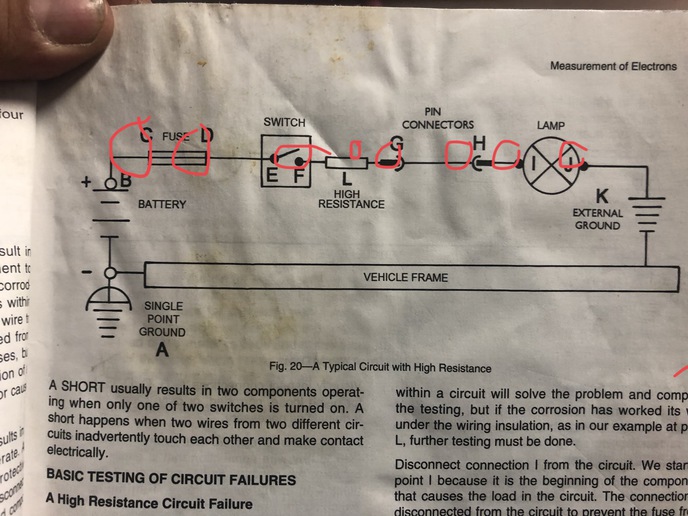If its not firing quit guessing and work through all my tips already posted below as well as my Ignition Troubleshooting
TROUBLESHOOTING A BATTERY POWERED EXTERNAL COIL TYPE IGNITION SYSTEM:
PRELIMINARY CHECKS:
(A) To see if it happens to be a cap n rotor problem and to see if at least the coil is firing, remove the coil wire from the distributor (leave coil end intact) and place its bare end to within 1/8 inch from tractor iron, turn her on n crank her over, and see if she jumps that gap with a good visible blue spark?????? If so but the plug wire ends (from wire end to 1/8 inch to frame) or the plugs themselves don?t fire, its a cap n rotor or plug wire problem. If the coil wire isnt even sparking, see below.
(B) Next open the cap and see that the points are gapped correct and indeed opening and closing as the engine is cranked and the distributor shaft rotates and MAKE SURE THEY ARE NOT BURNED OR PITTED OR CARBONED UP BADLY !!!!!!!!!!!! If so, running a point file between them to clean them up might make her run again HOWEVER that?s only a temporary cure, so if that cleaning makes her spark, INSTALL N GAP NEW POINTS. In the event they appear good but only gray oxide coated, non abrasively clean/buff/polish them using say a dollar bill or shop cloth etc. and see what happens.
MORE TROUBLESHOOTING IF ALL THE ABOVE STILL FAILS TO MAKE HER SPARK
1) THE VERY FIRST THING YOU GOTTA HAVE is voltage to be present on the coils high supply (NOT to distributor) terminal when you turn the Ignition switch ON. If not she cant ever fire, but in the event the ignition switch or circuit/wire down to the coil or any Ballast Resistor is bad or open, you can HOT WIRE it by jumping a hot ungrounded battery voltage source to the coils high input supply (NOT to distributor) side n see if she runs then???? If she fires hot wired, you could have a bad ignition switch ((That can happen, when Ignition is on, the switches IGN terminal must turn hot)),,,,,,,or an open Ballast (if it has one) or a bad/open wire from switch to coil.
If the switch is good, if you turn the ignition switch on and place a test lamp on the coils high (NOT to distributor) terminal SHE MUST LIGHT UP. If not again, look for an open Ballast Resistor (if it has one, it should read around 1.25 to 2 ohms across its terminals) or bad/open wires from the switches IGN output down to the Ballast (if it has one) and distributor.
2a) When the Ignition switch is turned on, voltage should appear on the coils high input side. That would be 6 volts on a straight 6 volt system or 12 volts on a 12 volt non external ballasted system, or around 6 volts on a 12 volt system that used a 6 volt coil plus an external Ballast Resistor and the coil is good and the points are closed and they and ALL wiring is good.
2b) To insure the coils low voltage primary winding is not bad/open, use an ohmmeter and measure its DC resistance between its lil + and -terminals. If its an open circuit (no continuity) its bad/open and will NOT work. It should measure around 1.25 to 2 ohms or so if its a 6 volt coil and maybe 2.5 to 3.5 if its a 12 volt internally ballasted coil. NOTE CAUTION have all leads and any voltage source DISCONNECTED FROM the coil for this simple primary winding continuity test. 3) Next, place your voltmeter or test lamp over on the coils other low to distributor terminal side, turn her on and crank the engine over.
4) A test lamp there should flash ON (when points are open) and OFF (when points are closed) as the engine is cranked slowly.
5a) If the lamp never comes on there, the coils primary is bad/open,,,,,,,,,,or the points are never opening,,,,,,,,,or theres a shorted/bad condensor (remove its lead to points and see if lamp comes on, if so, bad shorted condensor or its wiring),,,,,,,,or the points wire is shorted,,,,,,,,or the distributors side pass thru stud is grounded (use ohm meter to test that),,,,,,,,,or the points may have a shorted spring.
5b) If the lamp never goes off as engines cranked, the points are not closing or are bad,,,,,,,,or the wire or circuit is missing from the distributor to the points,,,,,or the distributors not well grounded to the tractor.
She cant fire the coil unless its low side is getting a conductive ground return path via closed points and then the circuit is open when the points open.
Be sure the condensor or its wiring is NOT shorted out and see if the lite comes on (when points open) with the condensor disconnected. If removing the condensor makes her spark, replace the condensor.
SUMMARY
Be sure the points are closing fully and open on high cam and ARE NOT BURNED OR PITTED OR CARBONED UP BADLY,,,,,,,theres voltage present on distributors high side at all times when ignitions on (or its a bad switch or open ballast or bad wiring to col),,,,,,,voltage on coils low side flashes on and off as distributor is cranked,,,,,,,,,condensors not bad/shorted,,,,,,,,no shorts in wires to points and no shorts in pass thru side out distributor stud,,,,,,,,coil has continuituy.
You may luck out n just need a new set of points. If the coil wire fires (see above) and the plug wire ends to 1/8 from frame but NOT the plugs, they are badddddddddddd. Check them BOTH.
Good Luck n God Bless, post back any questions and your findings and any questions.
John T
John Ts Ignition Troubleshooting

